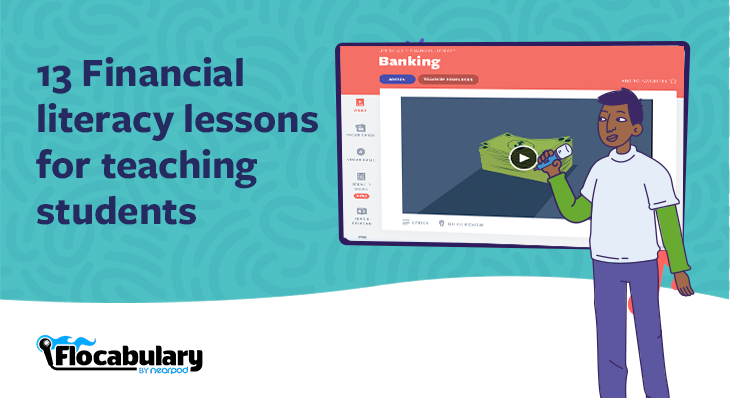
13 Financial literacy activities and lessons for teaching students
When is Financial Literacy Month in school?
When it comes to literacy, there is a growing emphasis on financial literacy to better support students not only in their youth but also in their personal and professional endeavors as adults. To underscore this, schools spotlight Financial Literacy Month, which occurs in April each year (coinciding with Mathematics and Statistics Awareness Month). The month-long focus evolved from the National Endowment for Financial Education’s original Youth Financial Literacy Day in 2003. Then, in 2007, President Obama made a proclamation to underscore the importance of being financially capable and changed the name of the effort to National Financial Capability Month.
Why should schools teach financial literacy?
Financial literacy can help set up students for success when it comes to achieving life goals and taking a balanced approach to managing debt and planning for retirement (it’s never too early!). Financial literacy speaks to not only understanding but also applying financial skills, especially when it comes to topics like personal finances, college planning, budgeting, and even investing. Integrating financial literacy into college planning can also empower students to make informed decisions about student loans, scholarships, future careers, and other financial aspects of their education.
While these topics can appear heady and often dry, Flocabulary has financial literacy activities and videos that stress the importance of learning financial literacy concepts and skills across elementary, middle, and high school grade levels.
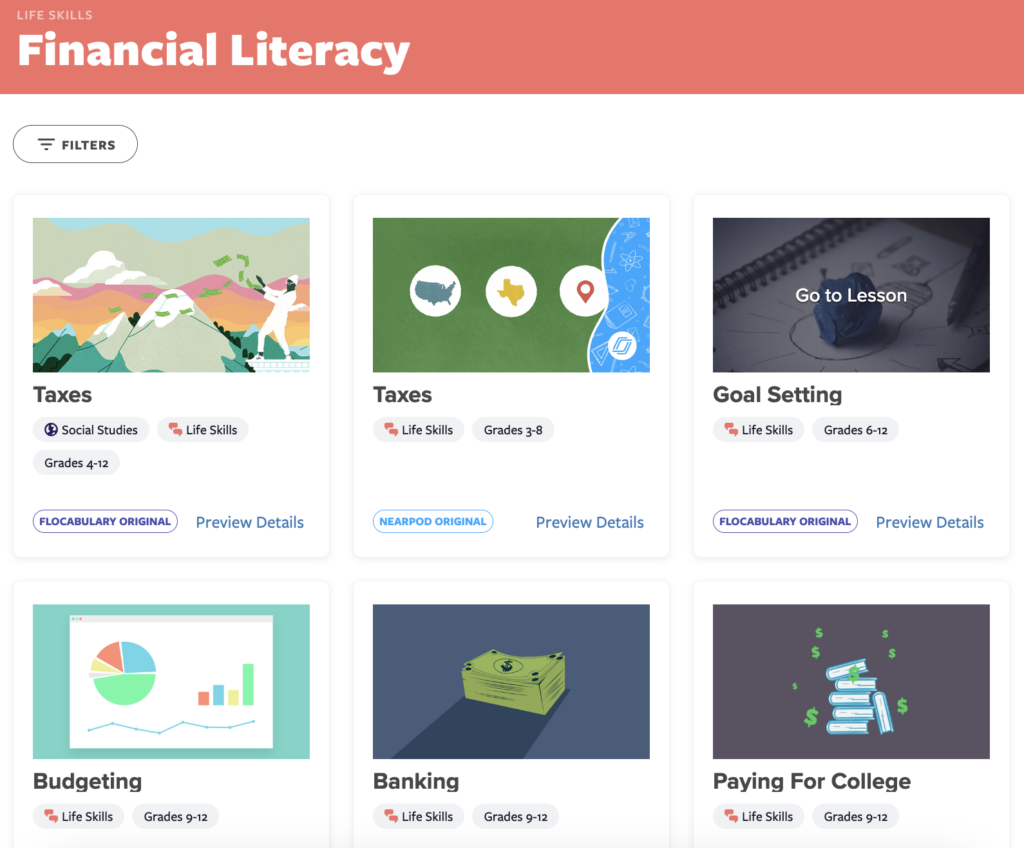
New to Flocabulary? Teachers can sign up for a trial to access our lesson videos and assessment activities. Administrators can get in touch with us to learn more about unlocking the full power of Flocabulary through Flocabulary Plus.
Why is vocabulary important when teaching financial literacy?
Financial literacy is littered with abstract concepts as well as academic and industry-specific language, which students may not yet be familiar with since they have limited real-world experience. Therefore, it is important to introduce this new vocabulary in an engaging and memorable manner, so that students can recall such terms when they become fiscally involved day to day. Educators and students recognize how Flocabulary’s lessons motivate students to learn while supporting their vocabulary acquisition through hip-hop videos and accompanying activities and quizzes. The benefits are numerous, from increased engagement to raised proficiency.
Financial literacy skills scaffold across the grades, from the early days of saving—whether in a piggy bank or at an actual bank—to the later years of earning a paycheck. By revisiting them in a spiraling manner, students will become more familiar with these real-life concepts and skills. Each Flocabulary lesson has a suite of activities along with the video, including Vocab Cards, Vocab Game, Break it Down, Read and Respond, Quiz, and Lyric Lab. Use these as financial literacy activities to provide students with additional ways to practice recalling and applying more challenging key terms to properly comprehend what they’re learning.
13 Financial literacy activities and lessons for teaching students
1. Goal setting
When it comes to financial literacy, goal setting is a lifelong skill. Too often in life, one’s finances can keep a person from reaching lofty goals. How can students begin to craft attainable goals early on? By leaning on the acronym SMART, students learn how to create goals that are Specific, Measurable, Actionable, Realistic, and Time-based. Goal setting is a fundamental competency in social and emotional learning (SEL).
Flocabulary’s Goal Setting video provides timely advice on how to dream big, plan ahead, and consider obstacles in order to turn small steps into big achievements. The catchy lyrics speak to creating a Plan A and Plan B to make sure that hopes aren’t just pipe dreams, especially when dollar signs are involved. Use the SMART acronym to address goal setting across the curriculum, and encourage students to have that “dream big” mindset.
Here’s an example of the types of financial literacy videos available on Flocabulary!
2. Taxes
As Benjamin Franklin forewarned, “Nothing is certain except death and taxes.” By learning about the purpose and uses of taxpayers’ money, students will begin to understand their financial responsibilities to this larger community that we call the United States. They will learn about the different types of taxes and why there is a bit of anxiety around the deadline for filing taxes each year.
From revenue and income and sales tax to the Internal Revenue Service to federal versus state versus local taxes, our lessons on taxes address the pros and cons of living in a high tax rate area. Both of the following financial literacy lessons will pique students’ curiosity to learn more about this annual contribution by citizens:
- Flocabulary – Taxes: This rap-infused lesson explains what taxes are and why we have them. Students will also learn about the different types of taxes they might see.
- Nearpod Original – Taxes: Why do we pay taxes? In this one-minute narrated video, students learn what our taxes pay for. A host explains the different types of taxes, and students consider the pros and cons of living in an area with a high tax rate.
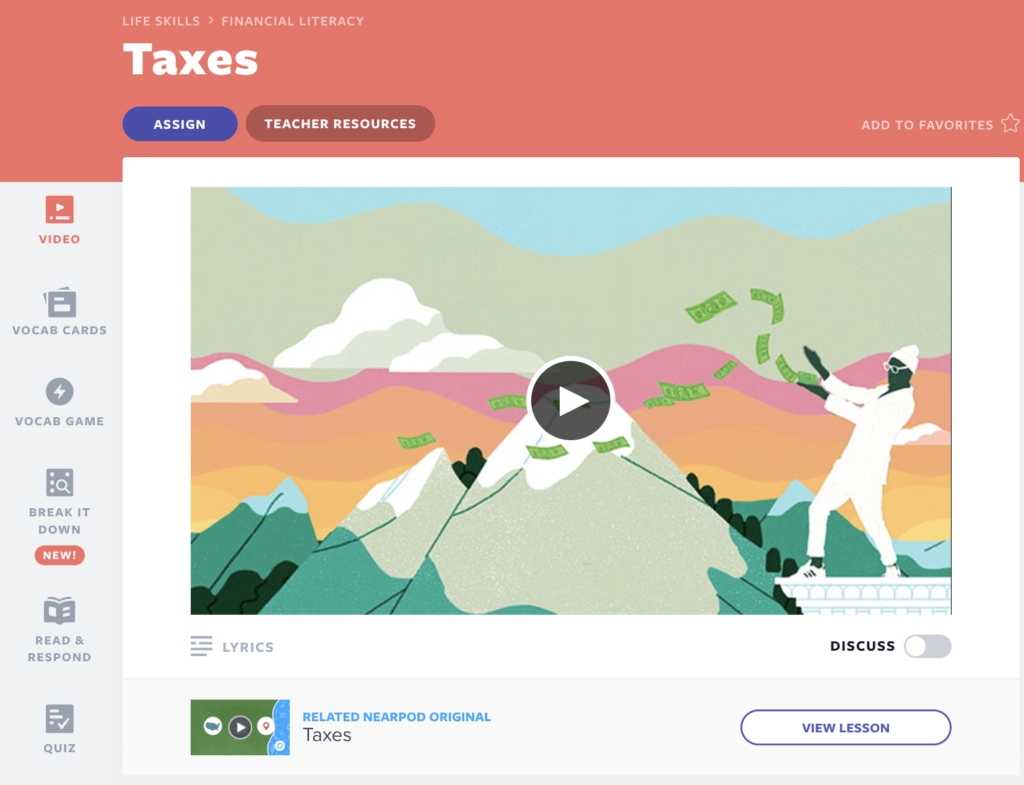
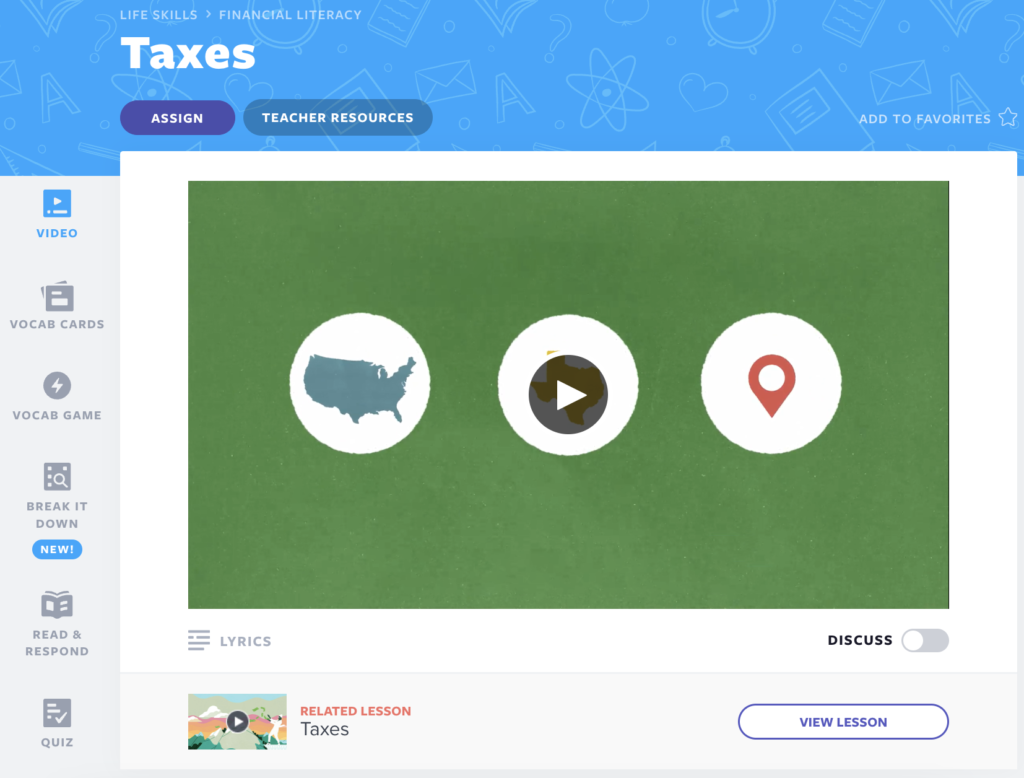
3. Budgeting
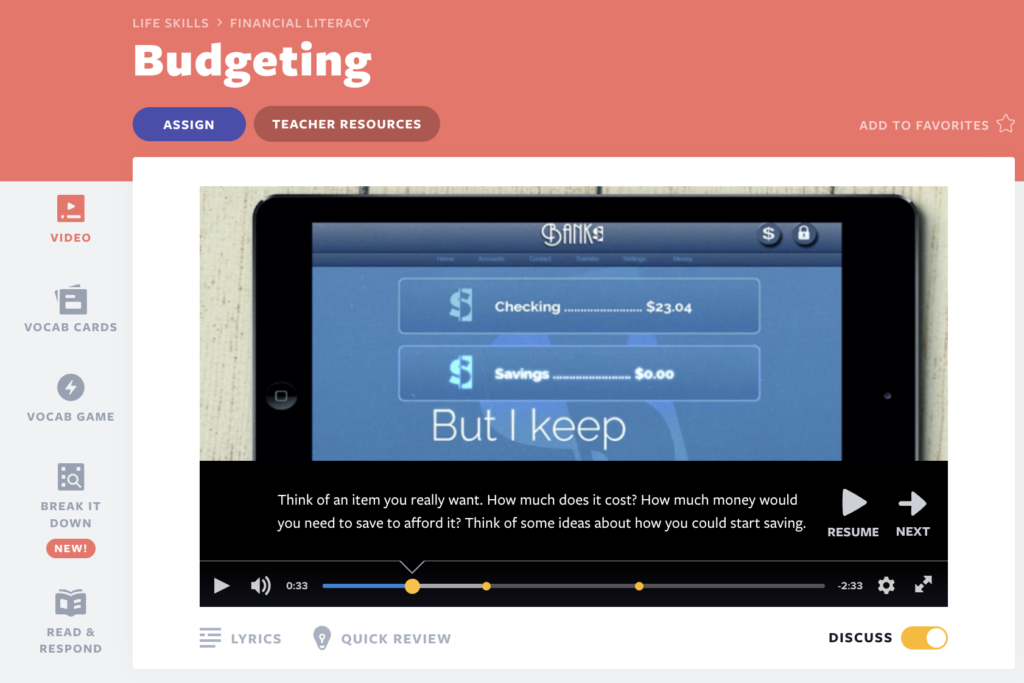
As kids begin to earn their own money for jobs well done, they need to better understand the concept of a budget. The concept of budgeting is wrapped up in actions, attitudes, and behaviors, so the Budgeting video dives into the difference between a WANT and a NEED. Toggle on the Discuss Mode to pause for discussion during the video and have your students reflect and share their perspectives; this helps to illustrate how income and expenses lead to either a plethora or lack of cash flow. Share the following video with your students and consider creating a mock budget for your classroom so that they can practice—with debits and deposits—their budgeting skills in a safe, fiscally responsible manner.
4. Banking
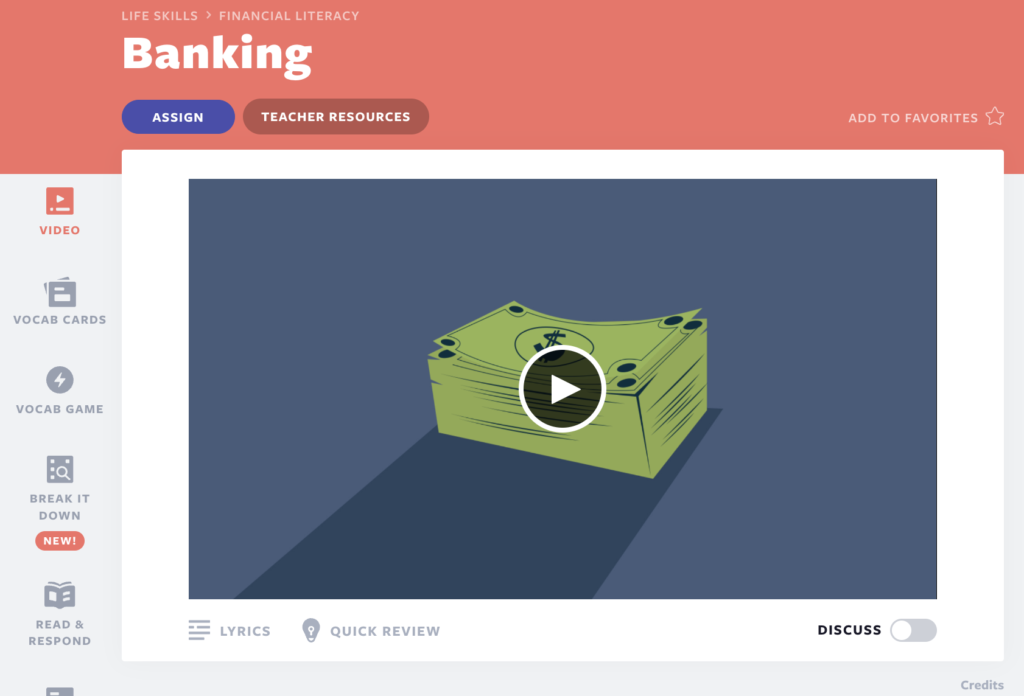
While most people know what a bank or credit union is, there remains a bit of mystery around the banking industry in general. This catchy rap familiarizes viewers with key terms like rate, balance, and principal. Plus, this Banking video explains the fundamentals of how banks function and are insured and how customers can optimize their interactions (and make some interest!). Consider how you can weave the concept of banking into your classroom by role-modeling bank transactions during a math class, supporting those foundational standards around Measurement & Standards across the grades.
5. Paying for college
A concern for students and their families is the high tuition these days for two to four years of both public and private college education. Even when adjusting for inflation, the upward trend is significant. Plus, in addition to the annual tuition are the related expenses of housing, transportation, meals, and class materials.
From financial aid and grants to scholarships and work study, Flocabulary’s Paying for College lesson has some sage advice around planning ahead to “invest in yourself” when it comes to evaluating all options and making decisions about paying for a college education. Add this lesson to your list of Financial Literacy Month ideas, as it’s essential for secondary students.
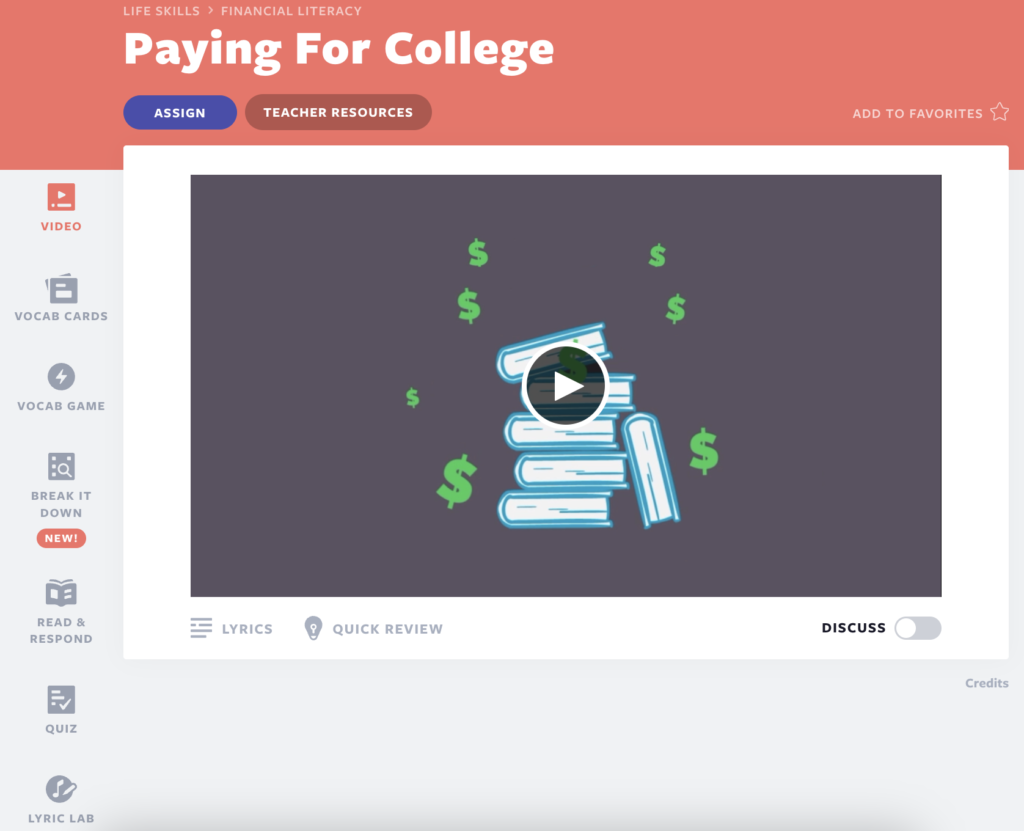
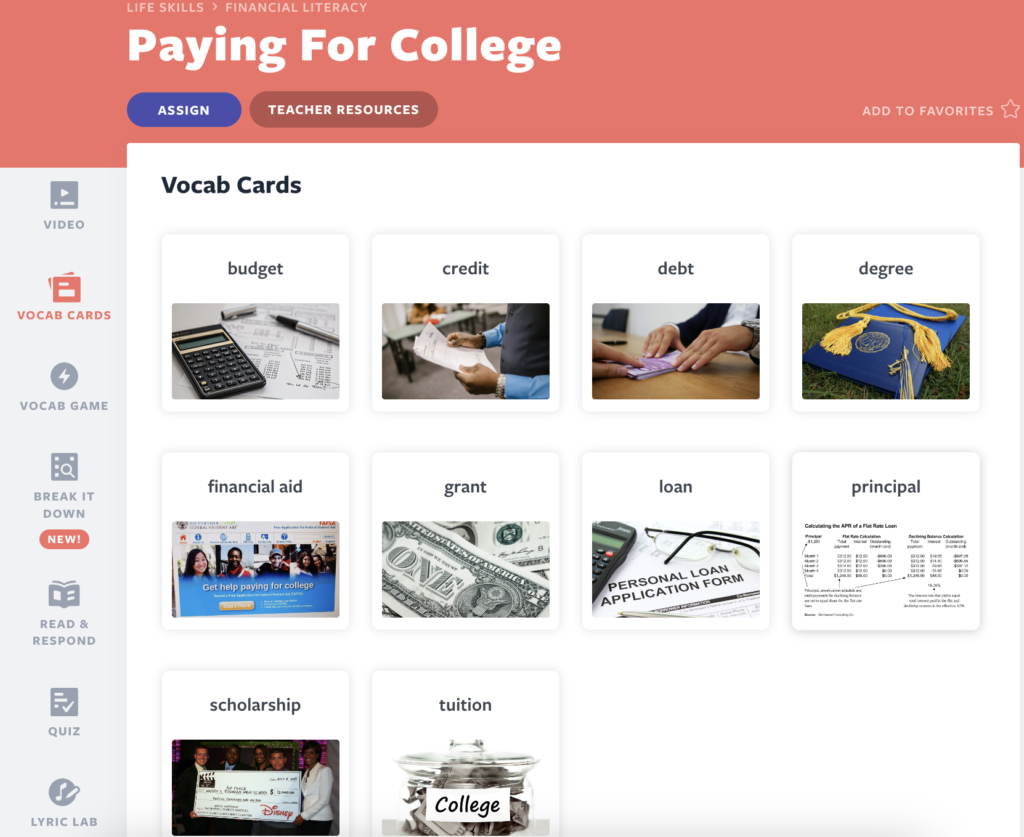
6. Student loans
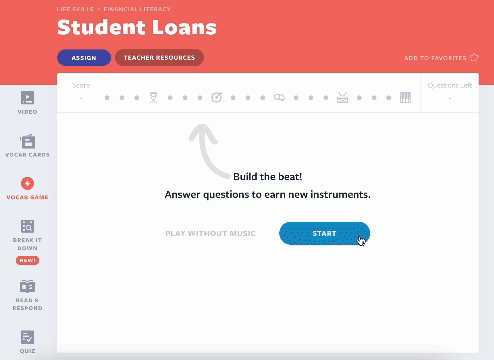
You’ve all seen the recent headlines about the growing amount of student loans that college students and graduates have amassed in recent years. Encourage your high schoolers to understand the benefits and responsibilities that come with taking out student loans at a young age. Help them sidestep the consequences associated with not paying back student loans in a timely manner. The Student Loans video is one that will help students make a responsible and informed decision when choosing a college. Many say that student loans are one of the first real-world “adulting” responsibilities that students have to bear, so as we all know … knowledge is power!
7. Credit cards
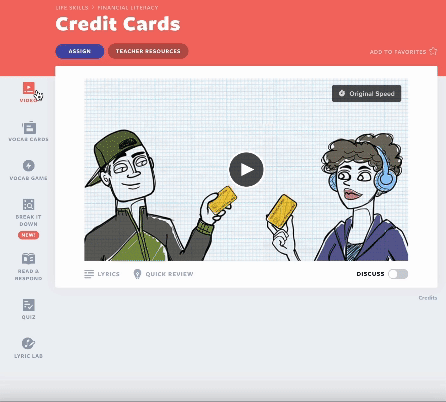
While it can be oh-so-easy to swipe, the ease of use doesn’t quite illustrate the responsibility that comes with using credit cards. Fundamental to financial literacy for students is not just understanding but knowing how to apply key skills, and credit cards require a solid understanding of debt, interest, and maintaining a balanced budget. Healthy financial habits are markers of success when it comes to financial independence. So, understanding how credit cards work is imperative before getting one in your name. This Credit Cards lesson has cross-curricular connections to social studies, as you can share early systems of barter and trading going as far back as when Mesopotamians and Harappans used clay tablets to track such exchanges.
8. Credit history
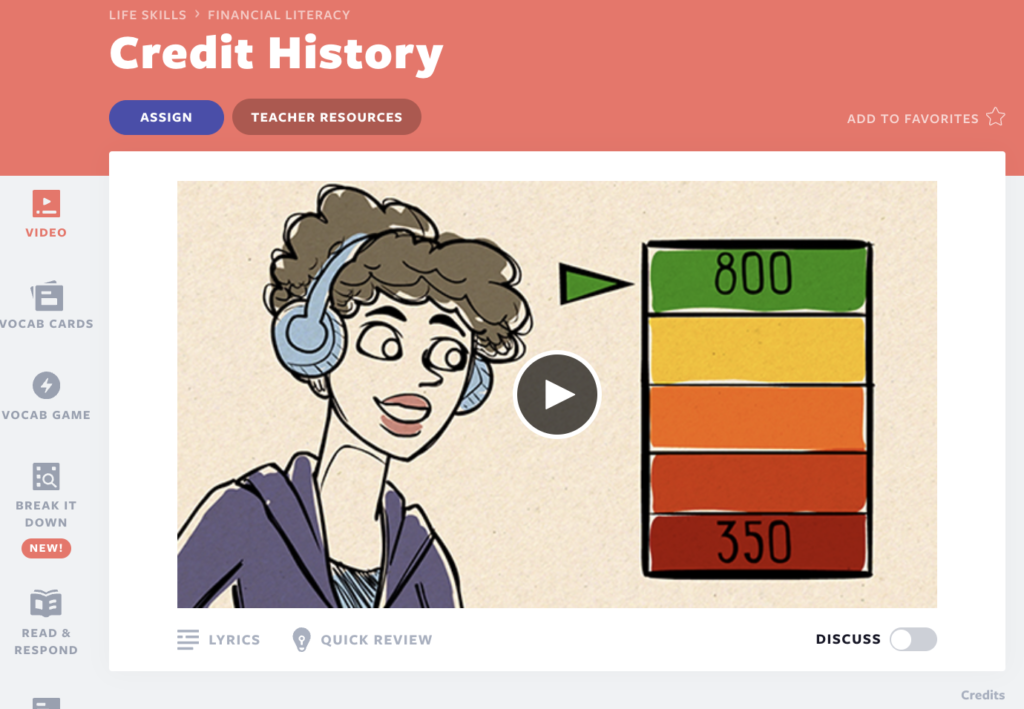
All ages can benefit from understanding how to build good credit over time, which is known as one’s credit history. The Credit History lesson dives into the factors that can affect one’s credit score—both positively and negatively. The lyrics describe how one’s credit score can influence future goals when it comes to borrowing money. The rap also recommends checking the accuracy of one’s credit score once a year to make sure that thieves and hackers haven’t affected it.
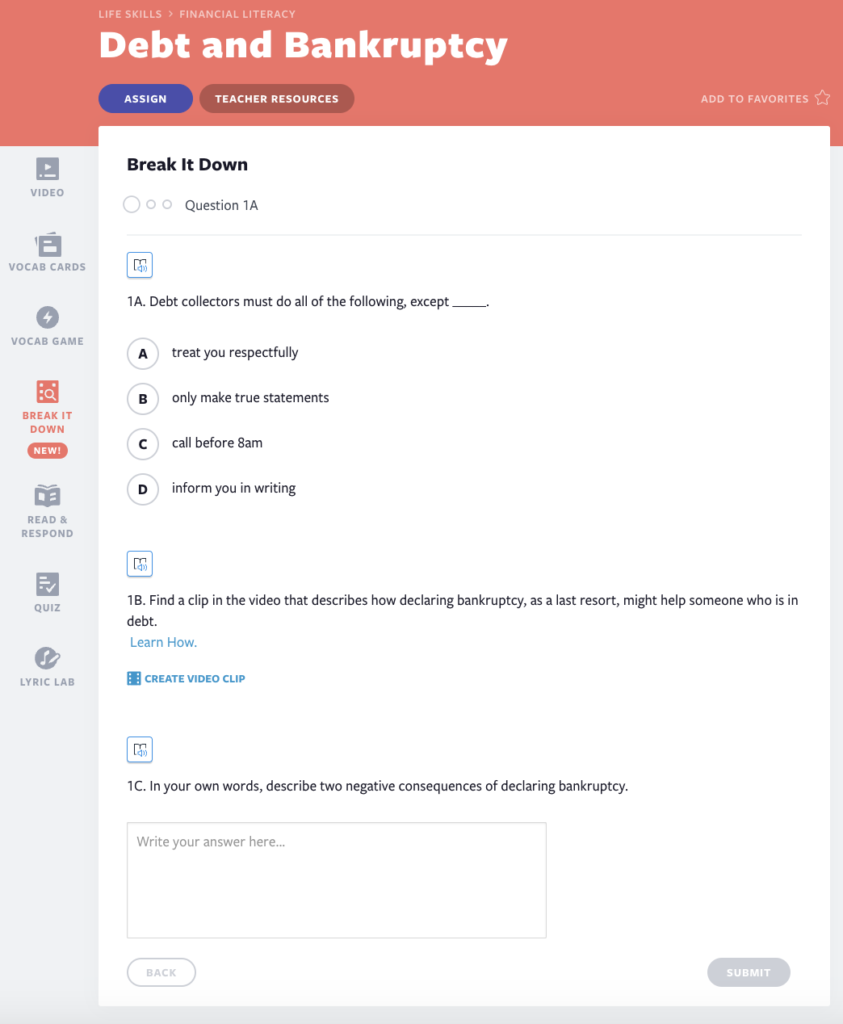
9. Debt and bankruptcy
Flocabulary’s Debt and Bankruptcy lesson delves into the legalities of debt collecting as well as consumer protection laws. It’s important to understand one’s rights. If debt becomes too overwhelming, there are options, yet it is crucial for students to understand the long-term consequences of declaring bankruptcy. For complex topics like debt, ask your students to complete financial literacy activities such as Break It Down on their own or in small groups to better cement their comprehension of these issues.
10. Choosing a career
Today, the average person will change careers 5-7 times in their lifetime. The average person will change jobs every three years or so, which is a marked shift from previous generations. So, how should students begin to think about their career path (or paths, plural) to optimize how they can build upon prior experience and expand their skills? They might need to plan for financial windfalls as well as dips throughout their life. Choosing a career is not all about the related salary, either, so have your students play devil’s advocate in thinking through all the meaningful aspects of a particular career.
In the Choosing a Career lesson, students learn about the connection between a desired career and the requisite steps to get there including assessing personal and academic strengths, learning about options, and taking advantage of all possible resources.
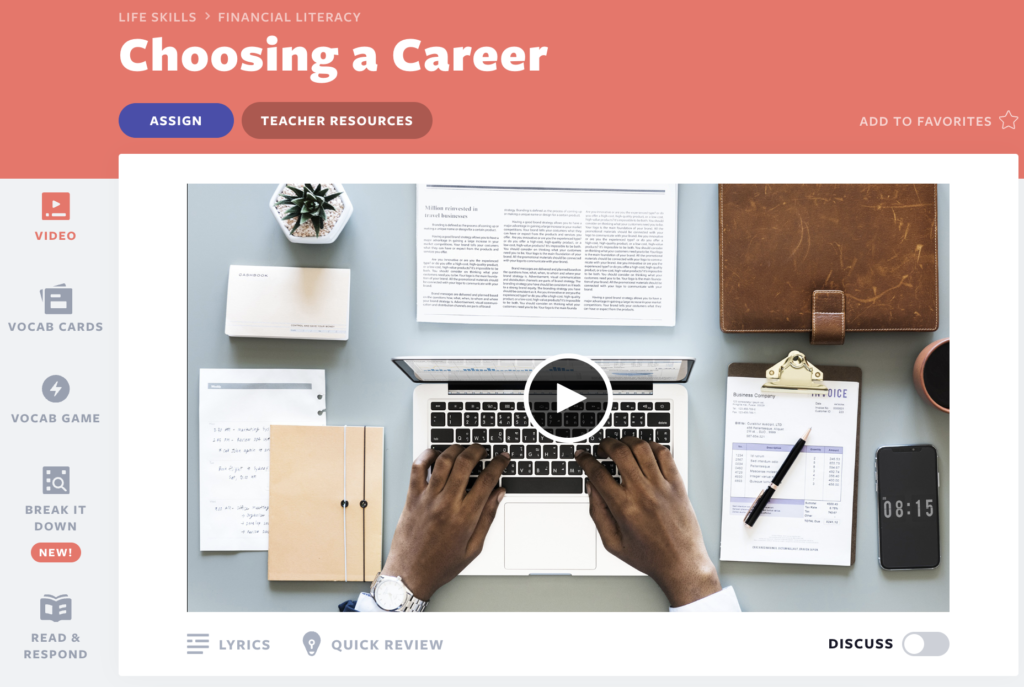
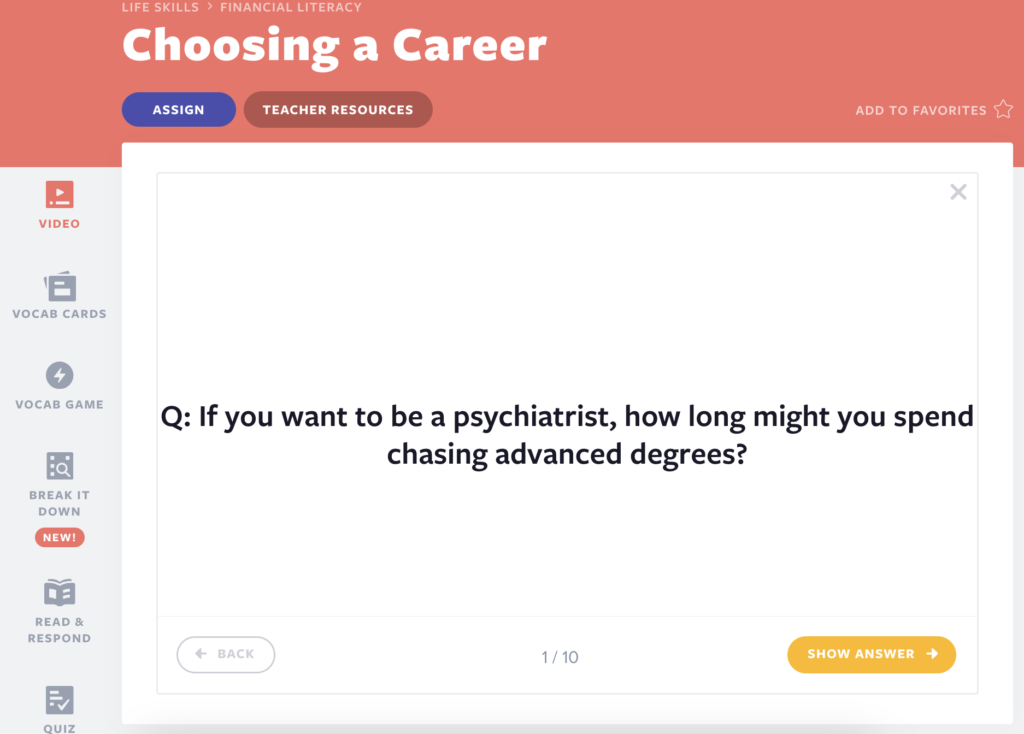
11. Employee benefits
With any job, there come benefits that will help you stay healthy and, hopefully, happy while fulfilling the responsibilities of your role and building a successful career. Many employee benefits that you can partake in have financial value—money you may not have to pay out of pocket, or ways to save money for later in life. From health and life insurance to time off and retirement, topics around pensions, vacation time, 401K, and other services should be part of a thoughtful decision when it comes to choosing which job offer to accept. Depending on your personal situation, some may be of more value to you than others.
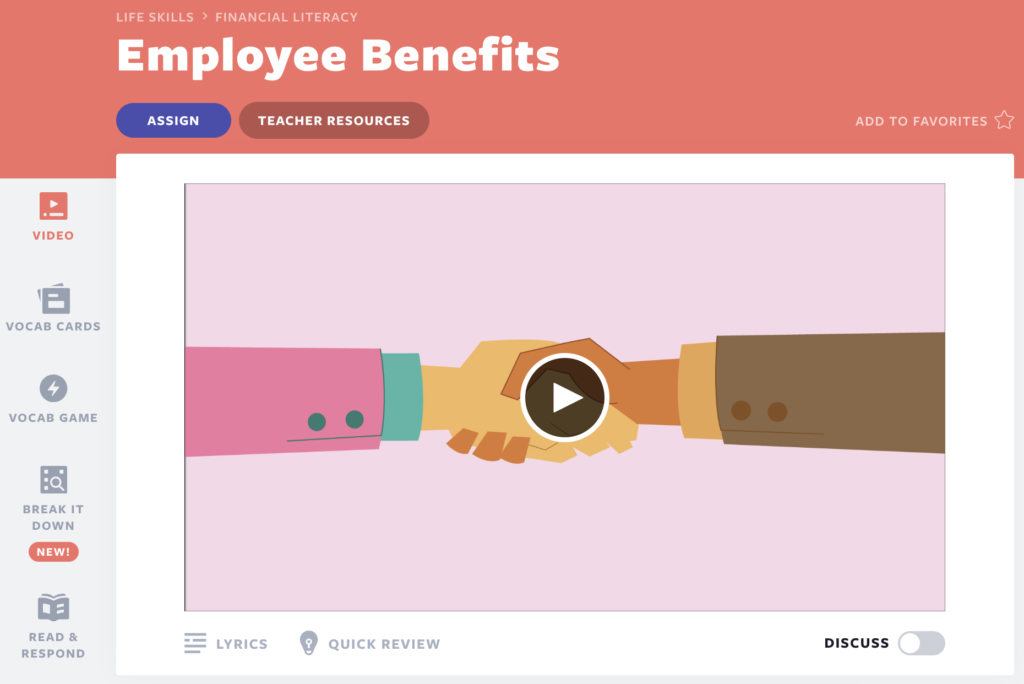
Check out the Employee Benefits video and then consider role-playing a hiring situation with students so that they better understand what questions to ask and which benefits to seek out depending on their personal situation. Key terms included in the lesson are premium, pension, 401K, term life insurance, permanent life insurance, and stock options.
12. Finding a home
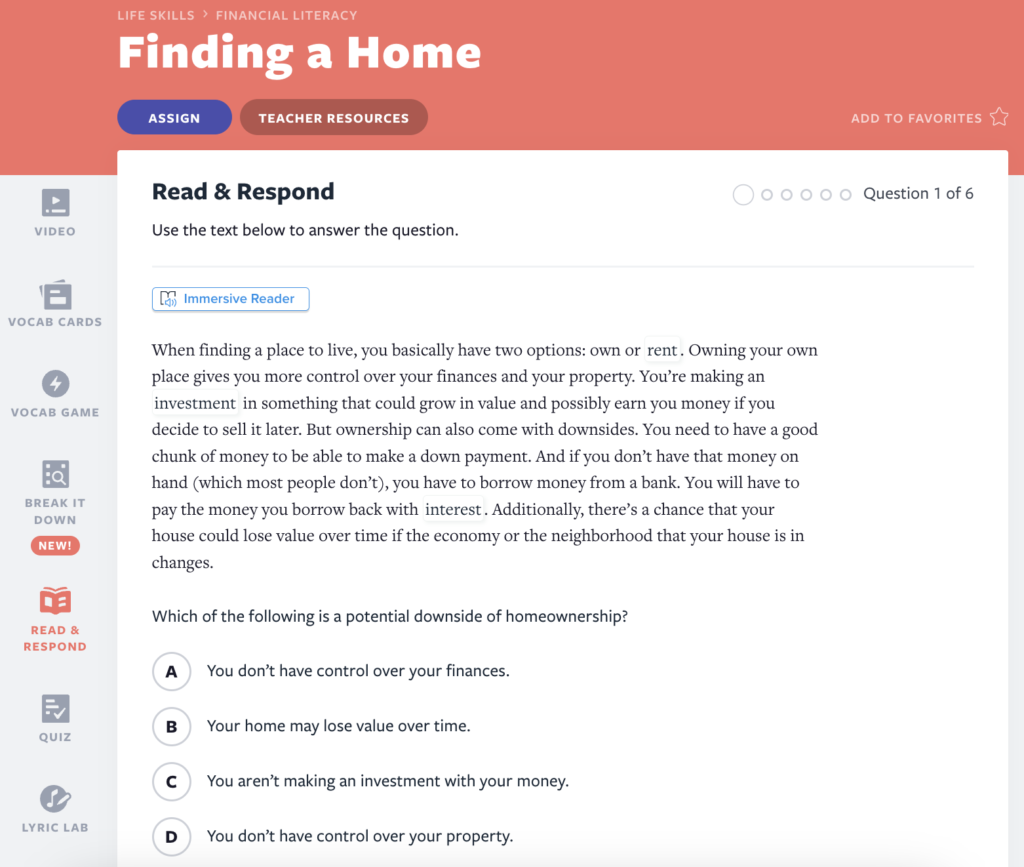
One of the biggest financial investments—for better or worse—is buying a home. In Finding a Home, students can debate the advantages and disadvantages of renting versus owning, all while diving into key vocabulary terms such as equity, mortgages, and fixed and adjustable rates. Challenge students to complete the Read & Respond activity for a bit of extra reading practice. Local newspaper real estate advertisements and online mortgage calculators are a fun way to put students in the shoes of a potential homeowner. Learning how to save, analyze the risks, and optimize on their investment is a set of skills that will help them dream big and support their individual and family-related dreams.
13. Investing your money
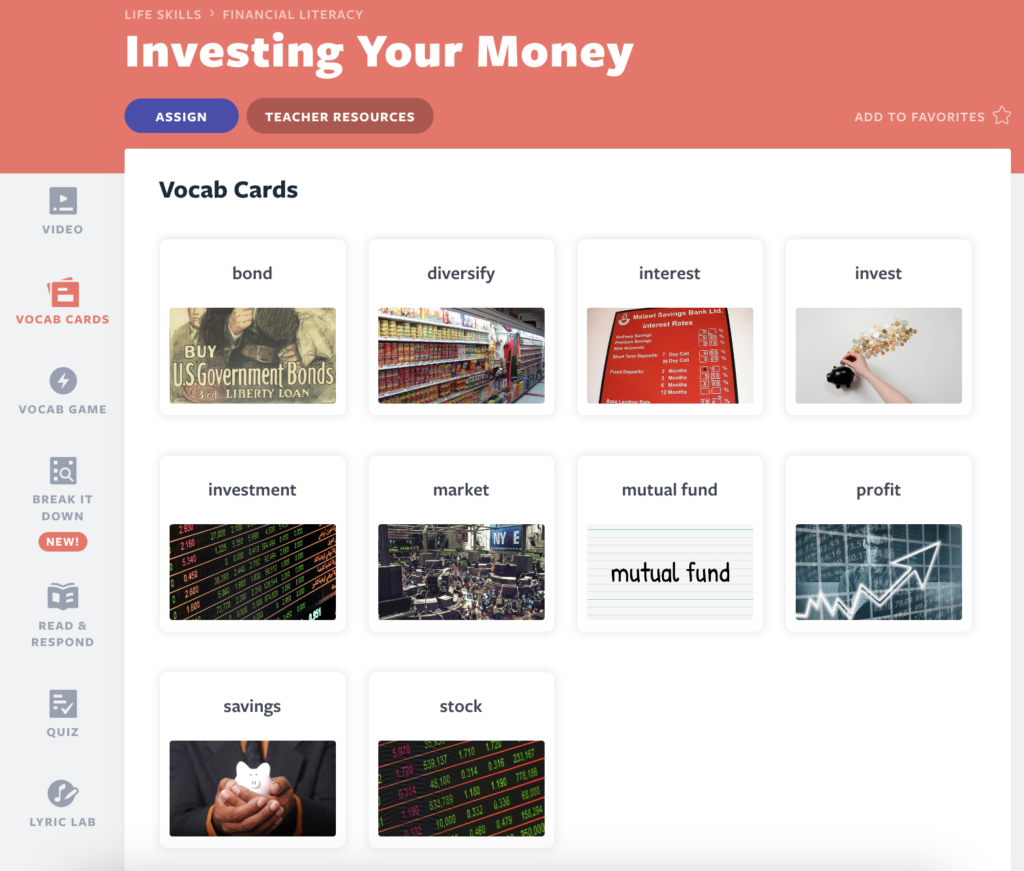
One of the more seemingly “adult” aspects of financial literacy is understanding the importance of making investments today to benefit your future tomorrow. From savings to bonds to mutual funds, the Investing Your Money video underscores the value (no pun intended) of long-term planning. It also describes the risks and rewards of being a shareholder in the stock market. There are many online resources that outline how to play a stock market game in your classroom over time so that students have the opportunity to understand the ups and downs in a safe manner (aka, without financial risk) before they enter the real world.
Start using Flocabulary to teach life skills
From The O’Jays to the Flying Lizards to ABBA, many groups have sung about money, but it’s time to introduce students to a new generation of lyrics and tunes from Flocabulary. Plus, did you know that in addition to April being Financial Literacy Month, it is also National Poetry Month? So, what better way to acknowledge both than to bring some rhyming verse and rhythm to the mathematical and logical ins and outs of finances? Flocabulary encourages kids to play with language while shoring up foundational skill sets that support their academic as well as social and emotional growth throughout the grade levels. During April’s National Financial Capability Month, pepper these videos and financial literacy activities into morning circle, advisory period, ELA, or math classes. This is a topic that often is undervalued yet has such practical application throughout one’s life—so while April is a great month to promote financial literacy skills for students, consider how you can weave these lessons throughout your curriculum all year long.
New to Flocabulary? Teachers can sign up for a trial to access our lesson videos and assessment activities. Administrators can get in touch with us to learn more about unlocking the full power of Flocabulary through Flocabulary Plus.
